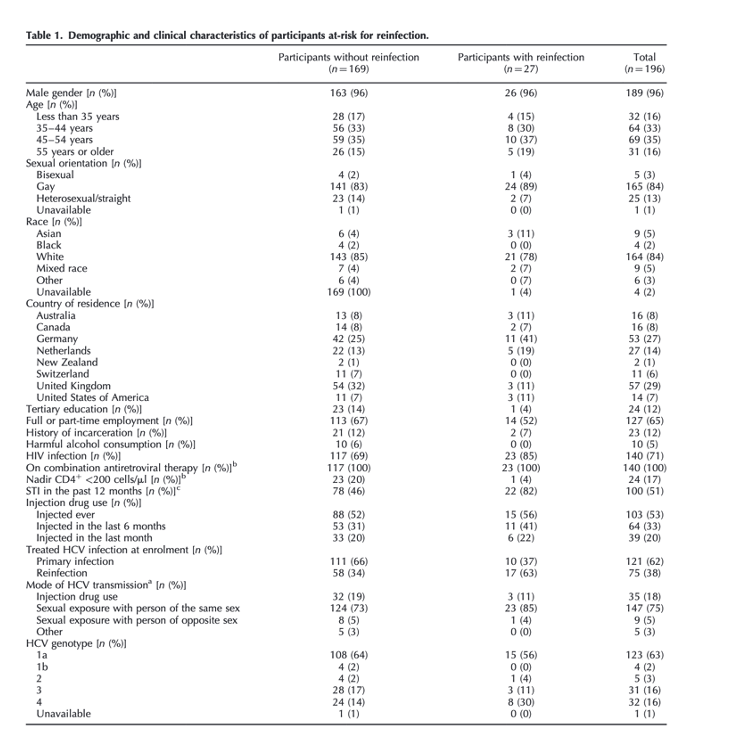| |
Reinfection incidence and risk among people treated for recent hepatitis C virus infection
|
| |
| |
Download the PDF here
In this international cohort composed predominantly of GBM with HIV from high-income countries, high reinfection incidence was observed among people treated for recent HCV infection, two to three times greater than contemporary reinfection estimates among at-risk populations treated for chronic HCV [8,9,15-17]. Reinfection was associated with a previous diagnosis of HCV reinfection, injection drug use posttreatment, condomless anal intercourse with casual male partners and geographic region. Although many participants diagnosed with reinfection were successfully retreated, one-third remained untreated at end of follow-up. Elimination strategies will be enhanced by diagnosis and treatment of recent HCV [18]; however, high reinfection incidence highlights the need for enhanced surveillance, tailored prevention strategies and rapid access to retreatment.
HCV reinfection incidence was significantly higher among people who reported injecting drug use following treatment, including among GBM reporting 'chemsex' involving injection drug use ('slamming', 'slamsex'). One-third reported needle/syringe sharing, higher than other studies of reinfection following recent (22%) and chronic (6%) infection among PWID [14,19].
Our study highlights that screening for and treatment of HCV reinfection, education focused on reinfection prevention and access to safe sex and harm reduction services are essential.
Injection drug use ever and within 1 month of enrolment was reported by 53 and 20%, respectively. Median age at injecting initiation was 36 years (range 14-61 years), higher among GBM (46 vs. 20 years). Injection drug use following treatment was reported by 40% (n = 80), among whom 81% reported injecting amphetamines and 34% use of unsterile needles/syringes. Among GBM (n = 169), condomless anal intercourse with casual male partners and group sex were reported by 82 and 63% prior to enrolment, and 87 and 58% during follow-up, respectively. Sexualized drug use ('chemsex') in month prior to enrolment and during follow-up was reported by 30% (involving injection drug use, 19%) and 47% (involving injection drug use, 34%).
Results:
Of 222 participants treated for recent HCV, 196 (62% primary infection, 38% reinfection) were included in the cohort at risk for reinfection, of whom 87% identified as gay or bisexual men, 71% had HIV and 20% injected drugs in the month prior to enrolment. During 198 person-years of follow-up, 28 cases of HCV reinfection were identified among 27 participants, for an incidence of 14.2 per 100 person-years [95% confidence interval (CI) 9.8-20.5]. Reinfection was associated with prior HCV reinfection [adjusted hazards ratio (aHR) 2.42; 95% CI 1.08-5.38], injection drug use posttreatment (aHR 2.53; 95% CI 1.14-5.59), condomless anal intercourse with casual male partners (aHR 3.32; 95% CI 1.14-9.65) and geographic region (United Kingdom, aHR 0.21; 95% CI 0.06-0.75). Among gay and bisexual men (GBM), reinfection was also associated with sexualized drug use involving injecting posttreatment (aHR 2.97; 95% CI 1.10-8.02).
Conclusion:
High reinfection incidence following treatment for recent HCV among people with ongoing sexual and drug use risk behaviour highlights the need for posttreatment surveillance, rapid retreatment of reinfection and targeted harm reduction strategies.

| |
| |
| |
|
|
|